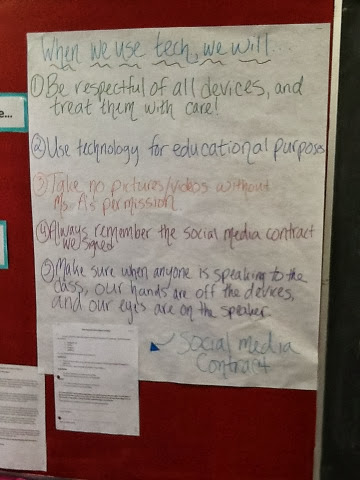1. Create and post routines, expectations, and procedures for using technology.
Duh. Of course setting routines, expectations, and procedures is important. It's the first thing we do to maintain management. But when I was in the excited frenzy of trying something brand new, I neglected to acknowledge that it needed to come with its own set of expectations. When my classroom had turned into Bedlam, I knew I needed to start over. Now, once my classroom is already running well, I spend time setting separate routines, procedures, and expectations specifically for using technology. I start by asking my students to brainstorm how they envision using technology in our classroom, and what they think is important in order to keep our classroom running smoothly. I like including students in this process to promote ownership and responsibility. I make a giant list of everything they come up with, and pool their ideas into a set of 5 simple, convenient, and visible expectations.
I also ask them to sign a social media contract, which is shaped by our school's core values of respect, responsibility, and honesty.
As in all endeavors we take on as teachers, when students understand and agree to what's expected of them up front, it allows us to be proactive classroom managers, instead of forcing us to waste time and energy putting out fires all over the place.
2. Loosen your grip. You are now a facilitator.
I can't say this enough. When you are incorporating BYOD into your classroom, it will get messy. Like really messy. You'll have days where kids are unimaginably perplexed, and days where the app that worked perfectly last period is now not working for no solvable reason. You'll have days where you will hear the same question asked enough times to make you want to rip your hair out. Just roll with it. Thank your students for their patience, and stay calm. Remind them that you are all in this together, and we can learn from what went wrong today. Don't run to their rescue with step by step directions for each task. Don't answer the same question more than three times; direct them to a classmate for who has already received the answer. Otherwise, you will literally drive yourself insane. Ask them to problem solve and encourage them to try something before asking the inevitable question, "What do I click next??"
3. Teach and model technology etiquette.
You know when someone swears they are listening to you, and they nod their head giving the impression that they are listening, but at the same time scrolling through Facebook or checking their email? Then you discover, after blabbing on for quite some time, that that person has not truly processed one word of your hilarious story? That's similar to what happened in my classroom when I tried to give directions once students were fully engrossed by their devices. I think the most important expectation, and the one that takes the most practice, is that when anyone (student or teacher) is speaking to our class, hands are off our devices and eyes are on the speaker. It even takes practice for me, and I've had to train myself not to be playing around on my ipad while my students are asking me even the smallest questions. By getting students in the habit of understanding there is a time and a place, we can help them to be respectful and responsible users of technology. We want them to be well versed in technology, while at the same time remembering how to respect and listen to one another.
4. Start small, and build slowly.
Don't try to incorporate BYOD in every facet of your teaching right out of the gate. It will turn out a lot like learning to juggle by throwing 5 balls into the air at once. It will fail miserably, and you might get hurt. Start by incorporating one app, and using it once or twice a week. When it's working really well, introduce something else. A great app to start with is Socrative, a response app that allows students to answer open ended questions and take quizzes using thier mobile devices. It's very user friendly, and it works like a charm.
5. Learn and take advantage of social networking.
If I were asked to give one single piece of advice to any teacher at any point in their career, it would be to join Twitter. You can create a Professional Learning Network made up of teachers from around the world. It's fantastic. It's like a daily mini dose of professional development. It's a great place to share what you're working on in your classroom, and to experience what other teachers are working on in their's. As an added bonus, you can find out what Justin Timberlake ate for lunch, if you're interested in that sort of thing. Follow me @JennaleeA. I promise I won't share with you what I ate for lunch.
Other great social networking sites worth joining and exploring are:
-Pinterest (a virtual pinboard)
-Goodreads (Great for ELA teachers. Keep track of, review, and share books you're reading)
Although it's absolutely been a tumultuous journey, incorporating BYOD into my classroom has been incredibly valuable. I love the idea that bringing devices into my classrom allows education to change and develop in the blink of an eye. Even more so, I love the idea that it allows me to instantaneously connect my students with the world around them.




